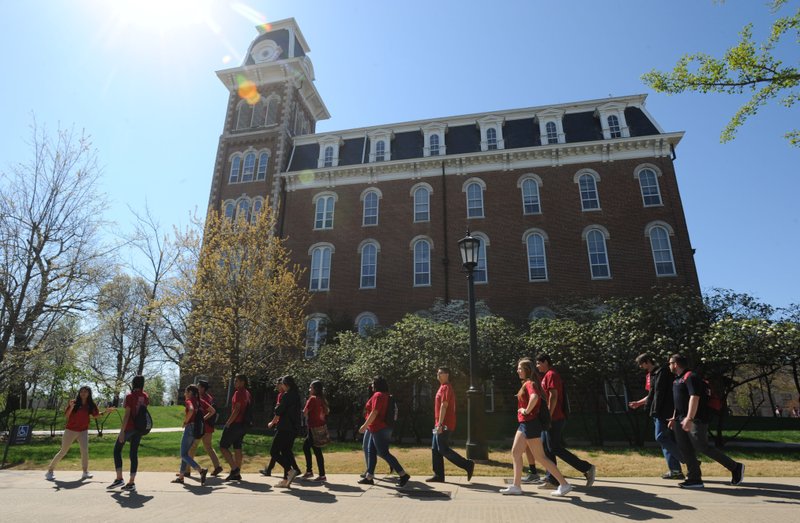FAYETTEVILLE -- Cuts to professional services, supplies and contract food services helped lower spending at the University of Arkansas, Fayetteville four months ago during the first full month of the pandemic, expenditure records show.
"As we went into remote working conditions, a lot of ongoing routine true maintenance activities that departments would be carrying out were stopped or delayed," UA spokesman Mark Rushing said in an email.
The UA spending category "maintenance and operations" fell by 30% in April compared with the same month the previous year. Expenditures dropped to $11.8 million from about $17 million in April 2019, UA spending records show.
The cuts, however, indicate little about what it takes to operate a university when students are living and learning on campus, said Doug Webber, an associate professor of economics at Temple University.
[CORONAVIRUS: Click here for our complete coverage » arkansasonline.com/coronavirus]
The April spending totals are the most recent to be made public at openua.uark.edu, an online database of university expenditures.
"In April 2020, they were running an online college, whereas in the fall -- assuming they open fully and are able to stay open -- then you might be able to see what did they cut and did anyone seem to notice a big difference in quality," said Webber, who studies the economics of higher education.
The University of Arkansas board of trustees in May approved a budget for 2020-21 with $767.8 million in total operating expenses. The total amounts to about 2% less than expenses approved by trustees last year for the state's largest university.
In April, spending records show that some other large budget categories did not change by much, including compensation and what are known as capital outlays.
UA weathered the final months of its fiscal year, which ended June 30, without furloughs or layoffs, Rushing added, so "therefore expenses in the categories of Compensation and Fringe Benefits did not decrease."
The "capital outlay" spending "would have been for construction work performed in the month of March," Rushing said. "When the university transitioned to working remotely in March, construction contractors working on campus continued their projects, so those expenses continued."
In April, UA auxiliary units -- including parking and transit, housing and athletics -- reduced spending by $2 million compared with the same month last year, Rushing said.
"With the auxiliaries, these reductions in expenses are directly attributable to the fact that students for the most part had transitioned to remote learning this April," Rushing said.
This meant "greatly reduced" transit operations and a decrease in housing maintenance and operations spending "due to very few students remaining on campus," Rushing said.
"Athletic events also had stopped by this time thereby reducing expenses related to carrying out those activities," Rushing said.
Looking at reductions by expense type, a reduction of about $1.12 million in April spending on insurance costs, again compared with the same month last year, mostly came about because of a change in the timing of payments, Rushing said.
Other spending reductions related to the campus changes were about a $513,000 reduction in contract food services and approximately a $505,000 reduction in spending on shop and industrial supplies, Rushing said.
On March 18, the campus moved to having only essential operations on campus. A few students remained, but dorms closed to all but those in need beginning April 3.
Spending on UA travel dropped by 80%, to $557,441 in April compared with $2.8 million in April 2019, according to UA spending records.
Rushing said expenses paid in April were almost all for either trips that took place before covid-19 travel restrictions or to offset internal charges for canceled trips.
"The limited number of trips that were actually made during the month of April were primarily for agricultural research with a total cost of $1,564.87," Rushing said.
Costs associated with the pandemic include refunds and credits given to students affected by housing closures. In April, UA estimated housing and meal plan reimbursement costs at more than $6 million.
UA has been allocated about $7.7 million in federal Coronavirus Aid, Relief, and Economic Security (CARES) Act institutional aid funding, which is separate from the approximately $7.7 million federal aid allocated to UA for distribution to students through emergency grants.
Other colleges and universities in the state also have been allocated CARES Act funds, which are available to institutions to pay for "costs associated with significant changes to the delivery of instruction due to the coronavirus," according to the U.S. Department of Education.
"My sense is that the pandemic-related costs for most people are going to be much greater than the CARES money they got," said Webber, the economist who studies higher education, referring to institutions.
Webber said another round of dorm refunds this fall would be "a massive revenue hit" should outbreaks lead campuses to close housing early in the semester. The revenue from campus housing "is a big ticket item that universities always just assumed was going to be there," he said.
UA and other large public universities in the state are planning to have students back this fall semester in campus dorms and for in-person classes. Two private universities in Arkansas, Hendrix College in Conway and Lyon College in Batesville, have said they will offer remote instruction rather than have students return for the start of their fall semesters.
